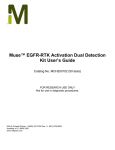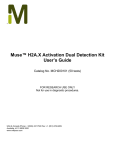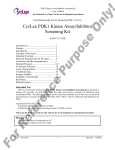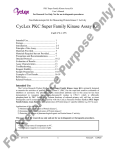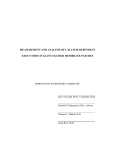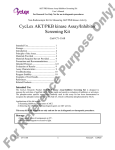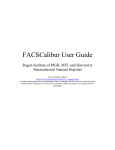Download Muse™ PI3K Activation Dual Detection Kit User's Guide
Transcript
TM Muse™ PI3K Activation Dual Detection Kit User’s Guide Catalog No. MCH200103 (50 tests) FOR RESEARCH USE ONLY Not for use in diagnostic procedures. USA & Canada Phone: +1(800) 437-7500 Fax: +1 (951) 676-9209 Australia +61 3 9839 2000 www.millipore.com Introduction EMD Millipore’s Muse™ Dual Detection kits are a series of products which include a pair of antibodies that bind to the same protein; one to detect total protein expression and another to detect the phosphorylated form of the same target. So by using two parameter analysis, we can achieve target specific detection of phosphorylation and, by doing so, eliminate false positives while enhancing the signal to noise ratio. Data generated using the Muse™ Cell Analyzer with the Muse™ software provides: • • • Percentage of inactivated cells Percentage of activated cells (via phosphorylation) Percentage of non-expressing cells Akt/PKB is a Ser/Thr kinase and a major known effecter of the PI3 Kinase pathway. It is involved in multiple signaling pathways that relate to many biological processes including metabolism, apoptosis, cell cycle control, angiogenesis, differentiation, and cell growth and proliferation. In mammals, three isoforms of Akt (Akt1/PKCα, Akt2/PKBβ, and Akt3/PKBγ) exists. They exhibit a high degree of homology, but differ slightly in the localization of their regulatory phosphorylation sites. Akt1 is the predominant isoform that is in most tissues and is thought to have a dominant role in growth, survival, embryonic development, and adipocyte differentiation. Akt2 is correlated with the regulation of glucose homeostasis and is the predominant isoform expressed in insulin-responsive tissues. Akt3 is abundant in brain tissue. Each Akt isoform is composed of three functionally distinct regions: an Nterminal Pleckstrin Homology (PH) domain that provides a lipid-binding module, a central catalytic domain containing Thr308, and a C-terminal hydrophobic motif containing Ser473. The activation of AKT is dependent on a dual regulatory mechanism that requires both its translocation to the plasma membrane and dual phosphorylation on Thr308 and Ser473 by PDK1 and the TORC2 complex, respectively. All Muse™ Dual Detection kits are optimized on the Muse™ Cell Analyzer. Both antibodies provided in the kit are carefully titrated and optimized together to ensure maximal performance when run in multiplex, alleviating the need for any additional optimization. This kit contains optimized fixation, permeabilization, and assay buffers to provide researchers with a complete solution for PI3K signaling analysis. Test Principle The Muse™ PI3K Activation Dual Detection Kit includes two directly conjugated antibodies, a phospho-specific anti-phospho-Akt (Ser473), Alexa Fluor®555 and an anti-Akt, PECy5 conjugated antibody to measure total levels of Akt. This two color kit is designed to measure the extent of Akt phosphorylation relative to the total Akt expression in any given cell population. By doing such, the levels of both the total and phosphorylated protein can be measured simultaneously in the same cell, resulting in a normalized and accurate measurement of PI3K activation after stimulation. Moreover, simultaneous measurement of both total and phospho-Akt confirms target specificity of the phosphorylation event. Together, a total and phospho antibody duo performed in multiplex provides an enhanced and more reliable detection of the phospho: total ratio within a mixed population. The antibody pair provided in the kit has been carefully titrated to ensure the ability to measure total and phospho-Akt simultaneously on the same protein for accurate determination of protein level and 1 activation. Sufficient reagents are provided to perform 50 tests. Detailed assay instructions are included to assist in analysis and to ensure the correct cell concentration is obtained during acquisition of sample data. For Research Use Only; Not for use in diagnostic procedures PI3K/Akt Signaling Pathway. As indicated in the diagram above, the PI3K/Akt signaling pathway has many branching points which regulate a large number of cellular processes such as cell survival, cell growth, and cell proliferation. The phosphorylation of Akt is the central node for this signaling cascade, hence, providing both total and phospho-Akt antibodies for accurate measurement of PI3K/Akt signaling. 2 Summary of Protocol Prepare cell cultures for experimentation (treated or untreated) ↓ Centrifuge cells at 300 x g for 5 min and wash once with 1X PBS ↓ Fix cells in Fixation Buffer for 5 min on ice, followed by a washing step ↓ Permeabilize cells with Permeabilization Buffer for 5 min on ice, followed by a washing step ↓ Add 200,000 cells to each tube (treated or untreated) A Add 10 µL of the antibody cocktail to 90 µL of 1X Assay Buffer per tub tube/test. Allow to incubate for 30 min at room temp (dark) Resuspend in 200 µL 1X Assay Buffer and acquire samples on Muse Cell Analyzer → Centrifuge cells at 300 x g for 5 min and wash with 1X Assay Buffer Kit Components • 20X Anti-phospho-Akt Akt (Ser473), Alexa Fluor®555 Fluor®555: (Part No. CS208206). One vial containing 250 µL • L 20X Anti-Akt/PKB, PECy5:: (Part No. CS208207). One vial containing 300 µL • 5X Assay Buffer: (Part No. CS202124 CS202124). One bottle containing 55 mL • Fixation Buffer: (Part No. CS202122 CS202122). One bottle containing 13 mL • Permeabilization Buffer:: (Part No. CS202125). One bottle containing 13 mL Materials Not Supplied 1. Test tubes for sample preparation and storage 2. Tissue culture reagents, i.e. HBSS, PBS w/o Ca2+ or Mg2+, cell dislodging buffers, etc. 3. Pipettes with corresponding tips capable of accurately measuring 10 – 1000 µL 4. Tabletop centrifuge capable of achieving 300 x g 5. Mechanical vortex 6. Deionized Water (for buffer dilution) 7. Cells of interest in suspension (e.g. Jurkat, NIH3T3, etc.) 8. Microcentrifuge tubes with screw caps, 1.5 mL (VWR, Catalog No. 16466 16466-030, 030, or equivalent) 9. Muse™ Cell Analyzer 10. Muse™ System Check Kit (Catalog No. MCH100101) 11. Guava® ICF Instrument Cleaning Fluid (Catalog No. 4200 4200-0140), optional 3 Precautions • The instructions provided have been designed to optimize the kit’s performance. Deviation from the kit’s instructions may result in suboptimal performance and may produce inaccurate data. • Some assay components included in the kit may be harmful. Please refer to the MSDS sheet for specific information on hazardous materials (MSDS forms can be found on the web page or by contacting Millipore technical services). • During storage and shipment, the directly conjugated antibodies may condense within the vial. For maximum recovery of the product, centrifuge original vial prior to removing cap. • The conjugated antibody is light sensitive and must be stored in the dark at 2 - 8°C. • Do not use reagents beyond the expiration date of the kit. Storage All reagents must be stored at 2 - 8ºC. All kit components are stable up to four (4) months from date of receipt if stored and handled correctly. Please avoid repeated changes in temperature as this will affect the integrity of the product. Before You Begin It is highly recommended that you run the cell samples shortly after completing the sample preparation. While some cell types have been shown to yield stable results for up to 24 hours after cell fixation/permeabilization/antibody staining if properly stored, the stability of individual cell types may vary. Time considerations: When dealing with phospho-specific activation detection, fixation of cell samples after cell treatment(s) is critical to capture the phosphorylation/activation event. Some activation state cell signaling responses are transient and may be lost if cell cultures are not fixed immediately following treatment. Cell fixation, permeabilization, and staining will take approximately 50 minutes. Acquiring data on your Muse™ Cell Analyzer takes less than 3 minutes per sample, depending on the cell concentration and desired number of events to acquire. Always perform a System Check prior to performing the assay. For details refer to the Muse™ Cell Analyzer User’s Guide. 4 Preparation of Reagents 1. Assay Buffer Assay Buffer is supplied at 5X concentration and should be diluted to 1X with deionized water prior to use. Prepared 1X Assay Buffer is stable up to one year. Store at 2 - 8ºC 2. Antibody Working Cocktail Solution The kit contains two (2) antibodies which can be used in multiplex. Prior to antibody staining of cells, prepare an antibody working cocktail solution by addition of the following: Add 5 µL of antiphospho-Akt (Ser473), Alexa Fluor®555 and 5 µL of anti-Akt/PKB, PECy5 conjugated antibodies into a centrifuge tube for a final volume of 10 µL total. This amount is good for one (1) test. *Based on the number of tests/tubes being performed, it is up to the end user to adjust antibody volume amounts at similar ratios (e.g. for 10 tests, the working cocktail solution will contain 50 µL of anti-phospho- Akt (Ser473) and 50 µL of anti-Akt/PKB for a total of 100 µL). Aliquot 10 µL of the working cocktail solution per test tube sample. This solution should be prepared as needed but if temporary storage is needed please keep in the dark at 2 - 8°C. Assay Instructions Note: This assay protocol has been optimized using both mouse embryonic fibroblast (NIH3T3) cells and human jurkat cells. However, this kit is suitable for measuring the extent of PI3K target-specific detection of activation (or deactivation) via phosphorylation on a variety of human and mouse cell types in which Akt is expressed. Alternate species reactivity must be confirmed by the end user. I. Cell Culture and Stimulation (Used for example purposes) 1. Prepare cells of interest into two tissue culture flasks (treated or untreated) overnight in a 37°C incubator with 5% CO2. Cells should be at about 90% confluent the next day. 2. For the flask labeled, “Treated”, treat cells accordingly (e.g. chemically treated using PDGF, Wortmannin, or compound of choice). The intent is to induce Akt activation/deactivation for the given cell type. The other flask labeled, “untreated”, will serve as a control. 3. Incubate the flasks in a 37°C incubator with 5% CO2. Exposure time and treatment concentrations are determined at the discretion of the end user. 4. Deactivate cells by exchanging out the growth media with fresh growth media or 1X PBS. *All cell treatments and experimental samples are determined by the end user. This section is provided only as an example for inducing an Akt response for measurement of phospho-Akt activation and/or deactivation. 5 II. Fix and Permeabilize Cells 5. After cellular deactivation, spin down the “treated” and “untreated” testing samples at 300 x g for 5 minutes and discard the media. 6. Resuspend cells by adding 500 µL of 1X Assay Buffer per one million cells (for larger cell samples, i.e.— 5x106 cells, add 2.5 mL 1X Assay Buffer to cell sample). Essentially, add 50 µL of 1X Assay Buffer for every 100,000 cells evaluated. 7. Add equal parts Fixation Buffer to cell suspension (1:1). So for every 500 µL of 1X Assay Buffer per one million cells, add an additional 500 µL Fixation Buffer for a total of 1 mL cell fixation solution, and mix sample by gently pipetting up and down. (Similarly, add 50 µL of Fixation Buffer for every extra 100,000 cells evaluated to keep the 1:1 ratio consistent). Incubate for 5 minutes on ice. 8. Spin down cells at 300 x g for 5 minutes in a tabletop centrifuge and discard supernatant. 9. Permeabilize cells by adding 1 mL ice-cold Permeabilization Buffer per one million cells and incubate on ice for 5 minutes (For smaller cell samples, i.e.—500,000 cells, add 500 µL ice-cold Permeabilization Buffer). 10. Spin down cells at 300 x g for 5 minutes in a tabletop centrifuge and discard supernatant. 11. Resuspend cells in 450 µL 1X Assay Buffer per one million cells and aliquot 90 µL per microcentrifuge tube (Compatible for the Muse™ Cell Analyzer; Please see Materials Not Supplied section on page 3). III. Cell Staining and Analysis 12. For single color staining (e.g. adjustment settings), add 5 µL of anti-Akt/PKB, PECy5 antibody to the microcentrifuge tube containing the cell suspension. 13. For multiplexing, add 10 µL of the antibody working cocktail solution as previously described to each microcentrifuge tube containing the cell suspension. 14. Incubate cell testing samples for 30 minutes in the dark at room temperature. 15. Following incubation step, add 100 µL of 1x Assay Buffer to each microcentrifuge testing sample and centrifuge at 300 x g for 5 minutes on a tabletop centrifuge. Discard supernatant. 16. Resuspend cells in each microcentrifuge tube with 200 µL of 1x Assay Buffer. 17. Acquire samples on the Muse™ Cell Analyzer using the onscreen instructions 6 Setup and Acquisition on the Muse™ Cell Analyzer Run a System Check prior to performing the assay. For information on Muse™ System Check, refer to the Muse™ Cell Analyzer User’s Guide. 1. Select MAPK Activation from the main menu. 2. Select Run Assay. 7 3. Adjust the instrument settings: • Load the sample for adjusting the settings and select Run. Note: Perform the adjust settings step using a negative control (e.g. total antibody), then verify the settings using a positive control. • Or, to retrieve previously saved instrument settings, select Retrieve Settings. For more information on retrieving settings, see the Muse™ Cell Analyzer User’s Guide. 4. Fine tune the settings for the PI3K EXPRESSION and CELL SIZE INDEX plot, if necessary. • Adjust the CELL SIZE INDEX slider accordingly to capture the cell population of interest (see on screen instruction for example). • Drag the threshold left or right to exclude cell debris. Drag to make large changes. Touch the arrow buttons located below the plot to make small changes. The arrow buttons appear after you touch the threshold function. NOTE: If the acquisition times out (after two minutes), you can select Abort to restart the adjust settings step or Next to accept the settings and continue to the next step. Capture cell population of interest by adjusting the CELL SIZE INDEX slider bar on the X-axis. Touch threshold to activate and adjust left/right to exclude cell debris. 8 Fine tune threshold adjustments by using the arrows below. 5. Select Next when you have completed the adjustments. 6. Fine tune the settings for the PI3K EXPRESSION vs. PHOSPHORYLATION plot, if necessary. • SETTING THE GATE: To set the quadrant marker properly, prepare a cell sample containing only the total antibody (e.g. 5 µL of anti-Akt/PKB, PECy5 antibody + 90 µL 1X Assay Buffer in a cell suspension). • Adjust the slider bars (on the X and Y-axis) to place all populations (Non-expressing, Inactivated, and Activated) on scale. If the cell sample is not treated (e.g. activated) a great majority of the cell population will fall either in the “Inactivated” (upper left) or “Non-expressing” quadrants (lower left). Adjust the quadrant markers to place the cell population(s) immediately to the left of the marker (see diagram below, Example #1). • However, in certain cases the activation of Akt can be constitutively activated (e.g. human Jurkat cells). And if evaluating PI3K inhibitors such as Wortmannin, LY294002, or U0126, adjust the quadrant markers to place the cell population (if activated) immediately to the right of the markers instead (see diagram, Example #2). Addition of such compounds will cause a left population shift, or “deactivation” of phospho-specific Akt signaling. • Adjust the quadrant markers. You can move the marker intersection in any direction, as well as adjust the angle of each line. To move the markers as they are, touch the open circle at the intersection and drag the markers to make large changes, or touch the arrow buttons below the plot to make small changes (A). To adjust the angle of either line, touch the solid circle and drag in an arc, or touch the arrow buttons below the plot (B and C). Example #1: Mouse NIH3T3 cells (Inactivated) A. Moving the quadrant marker B. Adjusting the X-axis 9 C. Adjusting the Y-axis Example #2: Human Jurkat cells (Constitutively activated) 7. Select Next when the marker adjustments are complete. 8. Verify the settings. If the settings are correct, select Next. Otherwise, select Back and repeat steps 4 through 7, as necessary. A. For Mouse NIH3T3 cells B. For Human Jurkat cells 10 9. Enter the sample ID by touching the field, then using the keypad to input the ID. Touch Done when you’re finished entering the ID. If necessary, change the Events to Acquire by touching the field, then selecting the value from the pop-up menu. Select Next. 10. Follow the onscreen instructions and mix the first sample. Load the sample on the instrument loading arm. Select Run to acquire the sample. During acquisition, live statistical values are generated and plotted onto a bar graph. Measurements include inactivated, activated, and non-expressing cells *Example shown: Jurkat cells treated with Wortmannin (to cause deactivation of Akt signaling) 11 11. When acquisition is complete, the results are displayed. If desired, select Plots to display a dot plot and a bar graph for the sample. Select to hide plots. Select to display plots. You can view or change the sample ID, as well as add annotations for the current sample by selecting the “Sample Info.” Tab. To print the results for the current sample select the printer tab. 12. (Optional) If changes are needed to the gates assigned, touch the dot plot to enlarge it, then adjust the cell size gate according, as described in steps 4 and 6, respectively. You cannot adjust the cell size threshold after the sample has been acquired. If you adjust the gate on subsequent samples and wish to apply the changes to other samples that you already acquired, select the Apply Changes button in the title bar. Select the samples you want to apply the changes to or choose Select All, then select Apply. The sample you originally made changes to must be selected. 12 Select to apply changes to other samples. 13. If no adjustments are needed, select Next Run and repeat steps 9 through 12 for the remaining samples. NOTE: During the run, a message may appear prompting you to load a tube of DI water for a Quick Clean. Load the water then select Clean to perform the Quick Clean. Select Next to continue with the run. The frequency of Quick Cleans was set by your system administrator. Your administrator may also have chosen to allow you to skip the Quick Clean when the prompt appears. You can choose to perform additional Quick Cleans at any time during a run by selecting Clean in the title bar, then Quick Clean from the menu. 14. When you have acquired the last sample, select Finish. 15. (Optional) Select Options in the title bar to rename the data set, export the data set, save the current instrument settings, or view the event log. Refer to the Muse™ Cell Analyzer User’s Guide for more information. 13 Results The software performs calculations and displays the data in two plots: • A dot plot displaying cells which are inactivated, non-expressing, and activated on a bivariate plot, indicating Akt expression and phosphorylation (or dephosphorylation) for a given testing sample. • A bar graph illustration of the same data, calculating the expression of each cell population as a percentage (%). Results from each run are stored in a data file, as well as its corresponding spreadsheet (CSV) file. The data file and spreadsheet file contain the following statistics: • Sample Number • Sample ID • Percent totals for the Inactivated/Activated/Non-expressing cell types • Mean Fluorescence Intensity for the Inactivated/Activated/Non-expressing cell types A. B. Figures A and B. Jurkat cells were exposed to 1µM wortmannin for 60 minutes at 37°C to inhibit the Akt signaling cascade response, fixed, permeabilized, and then stained with both anti-phospho- Akt (Ser473) and anti-Akt/PKB antibodies in multiplex. Samples were acquired using the Muse™ Cell Analyzer and statistical results are shown above. Figure A shows the results summary, while Figure B shows results displayed by both dot plot and bar graph data. The statistics captured in this assay show the relative percentages for each population as it is calculated within the total cell population. Cells which express Akt can be seen by the data on the top two quadrants of the dot plot (inactivated and activated, representing about 81.2% of the total cell population. But of this cell population, 69.4% is deactivated upon treatment, attenuating the constitutive activation of the Akt signaling pathway in jurkat cells. By presentation of both datasets, one can now determine the total: phospho ratio within their testing samples. 14 C. D. Figures C and D. NIH3T3 cells were exposed to 50 ng/mL PDGF for 5 minutes at 37°C to activate the Akt signaling cascade response, fixed, permeabilized, and then stained with both anti-phosphoAkt (Ser473) and anti-Akt/PKB antibodies in multiplex. In a similar fashion, samples were acquired using the Muse™ Cell Analyzer and statistical results are shown above. Figure C shows the results summary, while Figure D shows results displayed by both dot plot and bar graph data. The statistics captured in this assay show the relative percentages for each population as it is calculated within the total cell population. Cells which express Akt can be seen by the data on the top two quadrants of the dot plot (inactivated and activated, representing about 94.9% of the total cell population. But of this cell population, 73.8% is activated upon treatment, confirming the activation of the Akt signaling pathway in stimulated NIH3T3 cells. By presentation of both datasets, one can now determine the total: phospho ratio within their testing samples. 15 Technical Tips 1. For cellular staining and analysis to be most effective, make sure that test cells have good viability prior to use. 2. For certain cell cultures cell pellets may become hazy or transparent following the fixation step, making it difficult to see. If sampling a small collection of cells for flow analysis, it is recommended that all steps be performed in a smaller collection tube (e.g. centrifuge tube) 3. Do not mix or interchange reagents from various kit lots. 4. Mix each cell sample thoroughly on a mixer before acquiring samples for consistent and accurate results. However, avoid vigorous mixing, which can cause cellular breakdown and splashing, resulting in volume loss and erroneous results. 5. The default number of events to acquire is 1000 events. You may select a different number, however, your statistical error will increase as you decrease the number of acquisition events. 6. If results deviate from expected values, prepare a freshly stained sample and reacquire the data. 7. Periodically run Quick Clean using a tube of DI water (after every 20 sample acquisitions) to prevent a buildup from cellular debris in the system. If your samples contain significant amounts of cellular debris, run the Quick Clean cycle more often to prevent clogs or blockage. 8. If you are acquiring data from a sample but the progress bar is not moving, there is probably either insufficient volume to continue to acquire the sample or a blockage of the flow system. First check to ensure that there is at least 100 µL of sample in the tube. If not, add additional buffer to bring the volume up to 100 µL or proceed to the next sample. If the sample volume is greater than 100 µL, then the lack of events is probably due to a clog. A clog or blockage can be caused by cell aggregates, cell debris, bleach crystals, or other particulates. Perform a backflush to flush out the clog into a tube containing 20% bleach. Then run Quick Clean to remove bleach residue. If this procedure does not alleviate the problem, refer to the Muse™ Cell Analyzer User’s Guide for additional troubleshooting tips, or contact Millipore Technical Support for help. 9. The Muse™ PI3K Activation Dual Detection Kit works best with samples in single cell suspension. Cell aggregates may clog or be excluded from the flow cell, affecting the accuracy of the results. If you wish to use the Muse™ PI3K Activation Dual Detection Kit with a “clumpy” cell line, it is recommended to order Muse™ Cell Dispersal Reagent (Catalog No. MCH100107) to disaggregate the cells. Contact customer service or visit our website at www.millipore.com/muse for detailed information on the Muse™ Cell Dispersal Reagent and assay method. For more troubleshooting tips refer to the Muse™ Cell Analyzer User’s Guide. For more information, contact the Millipore office nearest you. In the USA, call 1-800-MILLIPORE (1-800-645-5476). Outside the USA, visit our website at www.millipore.com/offices for up-to-date worldwide contact information. You can also view the tech service page on our website at www.millipore.com/techservice. 16 Troubleshooting Potential Problem Acquisition taking longer than expected or progress bar stops during acquisition Instrument clogging Experimental Suggestions Ensure that the System Check procedure was run and passed. If the progress bar stops during acquisition, the fluid system may be clogged. Run a Quick Clean procedure to clean the capillary. It can be performed during or after an assay. If the instrument is clogged, run a Quick Clean procedure to clean the capillary. It can be performed at anytime during an assay between samples. Since phospho-specific activation can be very quick, transient responses, in order to capture this phosphorylation event samples must be immediately fixed to “freeze” the given activation state in time. No detectable phosphorylation / activation in testing samples Low Cell Concentration Ensure that cells are counted properly prior to beginning the experiment. The assay instructions are optimized to give you a range of cells between warning during 300–700 cells/µL in the final sample volume so accurate population count acquisition results are obtained. A substantial decrease in cell numbers can lead to difficulty in adjusting settings. High Cell If the concentration of the stained cell sample is high (>1200 cells/µL), dilute Concentration the sample further with Muse™ Cell Cycle Reagent to adjust the cell concentration between 300 and 700 cells/µL. warning during acquisition High %CVs (wide Although the assay procedure has been optimized to function for multiple peaks) or false peak cells types, every cell line behaves differently. The wide peaks or false peak may indicate that: • The sample is poorly fixed and stained as a result of cell aggregates. Ensure your sample is a single-cell suspension before fixing and staining. • Cell concentration is too high. Decrease the number of cells by diluting the sample to 300–700 cells/µL. The Muse™ Cell Analyzer gives the most accurate data when the flow rate is between 300 and 700 cells/µL. Low level of staining • Although the assay procedure has been optimized to function utilizing multiple cell types, every cell line behaves differently. A low signal may indicate that the cells need to be stained at a higher volume. • Verify that the System Check procedure was performed and the results passed. Variability in day-to-day • If the results are inconsistent, check that the samples were well mixed prior to acquisition. Cells may quickly settle in your samples and your experiments results will be inaccurate unless the cells are mixed just prior to acquisition. • Monitor experimental cell cultures to ensure that cell viability and cell numbers being analyzed are consistent. Any drop in cell numbers or viability can influence experimental results. • If there appears to be day-to-day variation of the staining pattern, ensure the Muse™ Cell Analyzer is working properly. Check the Muse™ System Check log to ensure day-to-day instrument variation is low. 17 References 1. Alessi, D. R., et al. (1998). 3-Phosphoinositide-dependent protein kinase 1 (PDK1) phosphorylates and activates the p70 S6 kinase in vivo and in vitro. Curr Biol.; 8(2):69-81. 2. Cohen, P., et al. (1997). PDK1, one of the missing links in insulin signal transduction? FEBS Lett; 410(1):3-10. 3. Alessi, D. R., et al. (1997). 3-Phosphoinositide-dependent protein kinase-1 (PDK1): structural and functional homology with the Drosophila DSTPK61 kinase. Curr Biol; 7(10)776-89. 4. James, S. R., et al. (1996). Specific binding of the Akt-1 protein kinase to phosphatidylinositol 3,4,5-triphosphate without subsequent activation. Biochem J.; 315(Pt3):709-13. 5. Cross, D. A., et al. (1995). Inhibition of glycogen synthase kinase-3 by insulin mediated by protein kinase B. Nature; 378(6559):785-9. Related Products 1. Muse™ H2A.X Activation Dual Detection Kit (Catalog No. MCH200101) 2. Muse™ EGFR-RTK Activation Dual Detection Kit (Catalog No. MCH200102) 3. Muse™ MAPK Activation Dual Detection Kit (Catalog No. MCH200104) 4. Muse™ Bcl-2 Activation Dual Detection Kit (Catalog No. MCH200105) 5. Muse™ System Check Kit (Catalog No. MCH100101) 6. Muse™ Count & Viability Kit (100T) (Catalog No. MCH100102) 7. Muse™ Count & Viability Kit (600T) (Catalog No. MCH600103) 8. Muse™ Count & Viability (200X) (Catalog No. MCH100104) 9. Muse™ Annexin V & Dead Cell Kit (Catalog No. MCH100105) 10. Muse™ Cell Cycle Kit (Catalog No. MCH100106) 11. Muse™ Caspase-3/7 Kit (Catalog No. MCH100108) 12. Muse™ MultiCaspase Kit (Catalog No. MCH100109) 13. Muse™ Mitopotential Kit (Catalog No. MCH100110) 14. Muse™ Cell Dispersal Reagent (Catalog No. MCH100107) 18 Warranty EMD Millipore Corporation (“EMD Millipore”) warrants its products will meet their applicable published specifications when used in accordance with their applicable instructions for a period of one year from shipment of the products. EMD MILLIPORE MAKES NO OTHER WARRANTY, EXPRESSED OR IMPLIED. THERE IS NO WARRANTY OF MERCHANTABILITY OR FITNESS FOR A PARTICULAR PURPOSE. The warranty provided herein and the data, specifications and descriptions of EMD Millipore products appearing in EMD Millipore’s published catalogues and product literature may not be altered except by express written agreement signed by an officer of EMD Millipore. Representations, oral or written, which are inconsistent with this warranty or such publications are not authorized and if given, should not be relied upon. In the event of a breach of the foregoing warranty, EMD Millipore Corporation’s sole obligation shall be to repair or replace, at its option, the applicable product or part thereof, provided the customer notifies EMD Millipore Corporation promptly of any such breach. If after exercising reasonable efforts, EMD Millipore Corporation is unable to repair or replace the product or part, then EDM Millipore shall refund to the Company all monies paid for such applicable Product. EMD MILLIPORE CORPORATION SHALL NOT BE LIABLE FOR CONSEQUENTIAL, INCIDENTAL, SPECIAL OR ANY OTHER DAMAGES RESULTING FROM ECONOMIC LOSS OR PROPERTY DAMAGE SUSTAINED BY ANY COMPANY CUSTOMER FROM THE USE OF ITS PRODUCTS. Unless otherwise stated in our catalog or other company documentation accompanying the product(s), our products are intended for research use only and are not to be used for any other purpose, which includes but is not limited to, unauthorized commercial uses, in vitro diagnostic uses, ex vivo or in vivo therapeutic uses or any type of consumption or application to humans or animals. (c) 2009 - 2012: Merck KGaA, Darmstadt. All rights reserved. No part of these works may be reproduced in any form without permission in writing 19 Cat No. MCH200103MAN October 2012 Revision A






















